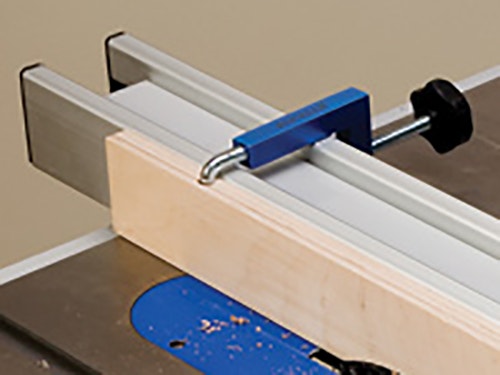Fence Clamps That Stay out of the Way
By itself, the fence that came with your table saw isn't always enough. Sometimes you need to add an "auxiliary" fence. But how do you keep it attached?
An auxiliary fence usually consists of nothing more than a straight, flat piece of hardwood attached to the face of your regular table saw fence. This fence supplement becomes necessary when you're doing anything that would cause the blade to come in contact with the fence - cutting rabbets with a dado blade, for example. The auxiliary fence lets you fine-tune the width of the rabbet without having to monkey with the dado blade, and keeps the blade out of contact with your saw's primary fence face.
An auxiliary can be put to other uses as well, like altering the length of your fence. And as many experts argue, there’s good reason for wanting to do so. According to Ian Kirby:
"It is dangerous to rip solid wood with a fence that extends all the way across the saw table. If the wood were to distort as it was being cut, it would bind between the blade and fence, throwing the workpiece out of contact with the fence and possibly kicking back.
When ripping, the fence should extend no farther than from the front edge of the saw no farther than the back of the saw blade. To convert a non-adjustable full-length fence for ripping, make a wooden auxiliary fence and fasten it to the regular fence."
From The Accurate Table Saw
Fair enough, but how do you "fasten it"? Some factory fences arrive already faced with a material that will take a screw, but attaching a supplemental fence with screws involves the extra work of drilling pilot holes, countersinking, and screwing in the fence in place every time you want to use it - not to mention the fact that many of us would balk at the thought of putting a bunch of screw holes in our table saw fence's pristine, smooth surface.
Clamping the auxiliary fence in place is the obvious solution, but there's a problem with that, too: One end of the clamp protrudes over the front of the fence face, limiting your access to the path of the stock, decreasing the usable height of the fence, and generally making a nuisance of itself.
The Universal Fence Clamp solves the problem ingeniously. One arm of this compact specialty clamp fits into a 3/8" hole in the top of the auxiliary fence - completely out of your way - while the other end secures the arrangement to your table saw fence with a few turns of a knob. The 1/2" to 5-1/2" clamping range will easily cover the width of your table saw fence and the thickness of any auxiliary fence you'll ever need.
It's a fast, affordable and efficient solution, and one that's definitely not limited to your table saw. The Universal Fence Clamp works great for stop blocks on your router table, shop-made re-saw fences, drill press stops and fences, and for any time you want to clamp a jig or fixture in place quickly, and set to work without the end of a clamp in your way.
Keep the inspiration coming!
Subscribe to our newsletter for more woodworking tips and tricks




